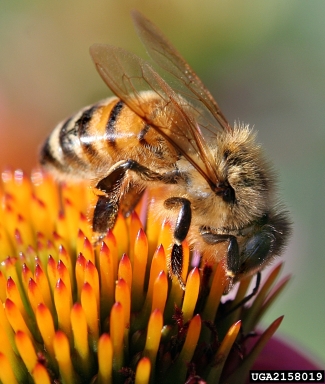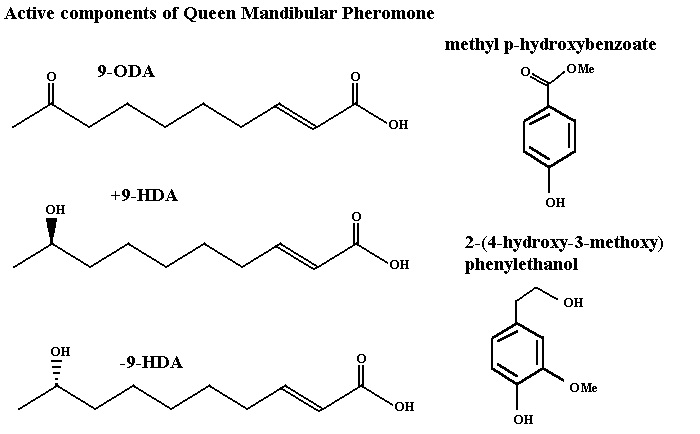Queen Succession in Honeybees Biology 342 Fall 07
by Laura Mulshine and Alice Runckel
Queen Succession in Honeybees

http://county.ces.uga.edu/cobb/Horticulture/Factsheets/Bees/Honey%20Bee%20Image.jpg (Oct. 9, 2007)
Mechanism
What makes a queen a queen?
Much of what makes a larvae develop into a queen involves her diet and care during her development. This aspect of mechanism is discussed in the Ontogeny section of this website. The other aspects, such as why the queen lays the majority of the eggs and what makes the worker bees care for the queen will be discussed below.
What makes the workers care for the queen?
Worker bees care for the queen because they are attracted to the pheromones excreted by her mandibular glands. Queens that have had this gland removed receive less attention from worker bees (Norman, 1961). The secretions of the mandibular glands also allow the drones to locate the queen prior to mating as well as prevent worker bees from reproducing. The Queen Manibular Pheromone (QMP) secreted by the mandiblar gland is made up of 5 known components; (E)-9-oxodec-2-enoic acid, both enantiomers of 9-hydroxydec-2-enoic acid, methyl p-hydroxybenzoate, and 4-hydroxy-3-methoxyphenylethanol. However, a synthetic cocktail of just these 5 components is not as functional a pheromone as natural QMP, suggesting that there are additional unknown compounds. Hives were selectively bred to have a high response to natural QMP but low response to synthetic QMP (containing the five known compounds). In doing so, Keeling and his colleagues identified four new compounds that also play a role in the pheromone. These compounds have no pheromone activity on their own and must be combined with the other components of QMP to elicit a response. This makes QMP one of the most complex pheromone blends used in all organisms (Keeling, 2003).

Image from www.chm.bris.ac.uk/webprojects2001/loveridge/index-page5.html
Chemical components of Queen Mandibular Pheromone.
Halting Ovarian Development in Worker Bees
For a colony to be eusocial, only the queen can lay eggs. It has been shown that a cocktail of pheromones released by the queen are responsible for halting ovarian development in the worker bees. Despite this mechanism, 4% of the worker bees in a hive have functional ovaries and can lay 7% of the male eggs present in a hive (Pirk et al., 2004). It was traditionally thought that worker bees preferentially discarded eggs from worker bees over those layed by the queen. However, no marker has been found that could differentiate between these two types of eggs. Pirk and his colleagues showed that this traditionally held theory may not be the case. Using an in vivo model they showed that eggs laid by worker bees were less viable than those laid by the queen. Worker bees clean the hive and discard eggs that stop developing. Worker bees are more perceptive in identifying eggs that have died than people. Pirk showed that the level of eggs being discarded by the worker bees matched the level of eggs that die due to decreased viability. Thus workers may not be able to differentiate between eggs laid by different bees.
The Transition from a Virgin Queen to an Egg Laying Queen
The level of Queen Mandibular Pheromone (QMP) secreted by young virgin queens is so low that worker bees are not attracted to them and thus do not care for them as they would egg-laying queens (Norman, 1961). The pheromones secreted by the queen’s mandibular glands (QMP) are used by drones to locate the queen prior to mating. After mating, the level of QMP secreted by the queen increase thus attracting worker bees to surround and care for her (Norman, 1961). It is therefore interesting that drones can pick up on even these low levels of QMP to locate virgin queens.